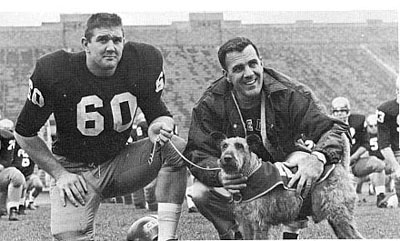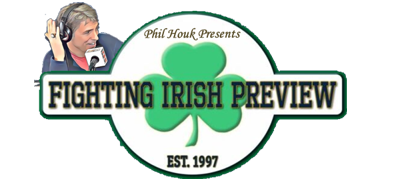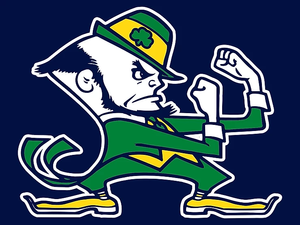(Updated: Jan.7, 2020) By: Phillip Houk of Fighting Irish Preview

Those who believe the “Fighting Irish” nickname to be a denigration of the Irish people, do not know the historical facts. Because, quite the opposite is true. Notre Dame’s “Fighting Irish” nickname is a tribute to an enduring relationship based on respect and affection.
So, how did Notre Dame athletic teams acquire their unique and proud nickname “The Fighting Irish”? The history of Notre Dame reveals a rich and respectful connection to the Country of Ireland and the Irish people that is so ingrained, that over time the University choose to honor that history with the iconic nickname.
Four of the six Religious who founded Notre Dame on November 26, 1842 with French priest Edward Sorin were Irish. The student body has always had strong Irish representation and in fact most of Father Sorin’s successors at the post of University President, have been of Irish descent. But the history of ND-Irish connections goes much deeper than that.
On July 2nd, 1863, Notre Dame was 20 years old, and on a Gettysburg battlefield known as The Wheatfield, Army Chaplain William Corby, a Notre Dame Professor and future President of the University, performed an inspiring act of faith and mercy. Amidst significant enemy threat, Father Corby mounted a large rock before the men of the Union’s legendary Fighting Irish Brigade. Legend has it that the “Fighting Irish” name, by which that group came to be known, was bestowed by none other than General Robert E. Lee. Lee as the story goes, greatly admired and respected their fighting prowess.
As Father Corby summoned the group of about 500, made up of predominantly Irish Catholic immigrants, they knelt before him. First, Father Corby shouted the prayers of general absolution to the soldiers. He then reminded them of their duties, and exhorted them not to waver as they upheld their flag. Officers later reported they had never seen such an inspiring scene. Seconds later, the men were sent to the rescue of the crumbling Union flank. Within minutes in brutal and bloody fighting, a third of the soldiers had become casualties, but the attack of “The Fighting Irish” brigade bought precious time for the Union.

A monument to this event stands at the site of Father Corby’s act and an identical one known as “Fair Catch Corby” stands on the Notre Dame Campus . Of 1,328 monuments that have been built at Gettysburg, Father Corby is the only Chaplin to be so honored. Corby, after serving as University President, oversaw the building of the Notre Dame Grotto.
During the the early 1900’s stereotypes and ethnic slurs were frequently expressed against Catholics and the Irish in the press. Because Notre Dame was largely populated by Catholics, and many of them Irish, it’s athletic teams were commonly referred to derisively as “the Catholics”, “the Papists” or “Dirty Irish”.
During the Rockne years of Notre Dame Football, ND was also unofficially referred to as “The Rovers” or “the Ramblers”. That was because they were not in a conference and some Midwest teams simply refused to play them. It is likely that at least some of the difficulty in scheduling was the result of religious bigotry toward Catholics. So Notre Dame choose to “ramble” or “rove” far and wide to find good competition.
Football coaching legend Knute Rockne, who had a keen mind for promotion, engaged in public relations that played upon his Notre Dame team’s humble roots and need to travel long distances to find competition. Some of the agents who had worked for the team used the words “The Fighting Irish” when engaging with the media. These PR efforts particularly paid off in the 1920s when one of Rockne’s former PR men, Francis Wallace went to work for the New York Daily News and used the “Fighting Irish” moniker in his column.
There was also a time Notre Dame was known unofficially as the “Terriers.” For many years, an IRISH Terrier nicknamed could be found on the ND football sidelines. The tradition started in 1924 when an Irish terrier was presented to Knute Rockne. The first Terrier was named ‘Tipperary Terrence’ and the most famous was known as ‘Clashmore Mike’. the Terrier mascot remained on the ND sideline until 1967 when the now famous leprechaun in a fighting pose was adopted.

In May of 1924 another event added to “The Fighting Irish”– Notre Dame connection.
According to historian Todd Tucker in the book Notre Dame vs. the Klan, ND students violently clashed with the anti-Catholic Ku Klux Klan who were demonstrating in South Bend that Spring. The fact that the student body was heavily of Irish descent and that those students embraced the full inference of the words “the FIGHTING Irish” is apparent. The power of the KKK was significant in the Hoosier State and at that time that included control of the governor’s office. According to the book, a weekend of clashes led by Notre Dame students helped bring an end to the KKK’s political power in the State of Indiana.
So as early as the Civil War, Our Lady’s University had a connection to the name “The Fighting Irish”. Several examples suggest that the Fighting Irish nickname was born not out of derision or stereotype but as a noble tribute to heroism and bravery.
Finally it all converged in 1927 and The Fighting Irish nickname came into common use. University President, The Rev. Matthew Walsh, issued the following statement to the University community, “The university authorities are in no way adverse to the name ‘Fighting Irish’ as applied to our athletic teams… I sincerely hope that we may always be worthy of the ideal embodied in the term ‘Fighting Irish.'” The Fighting Irish identity of the University, long a part of the university’s esteemed fabric, became official.
Today, Notre Dame’s connections with Ireland continue. Twice in their history, 1996, and 2012, Notre Dame Football has traveled to Dublin and played games against the Naval Academy. In 2020, they plan to once again the Irish return to Dublin, again to play Navy. (Ed. note: On June 2, 2020 the University announced that this game had been moved to the Naval Academy Stadium in Annapolis Maryland, “due to the Coronavirus pandemic.”. In 2021 it was announced that the Irish were again scheduled to return to Dublin in 2023. )
In the area of academics, Notre Dame boasts the Keough-Naughton Institute for Irish Studies, an extensive study abroad program in Ireland, and the Notre Dame campus is the largest center for the study of the Irish language in the world, outside of Dublin.
At Notre Dame’s Commencement in 2006, Ireland’s President Mary McAleese addressed the graduates and made reference to “The Fighting Irish” identity of the University: “The language you use here, the ‘Fighting Irish’ … what we actually mean mostly when we talk about it is an indomitable spirit, a commitment, never tentative, always fully committed, to life itself … that’s really the spirit of the Fighting Irish.”
The “Fighting Irish” nickname was born out of a deep and historical ND connection to the Country of Ireland and those of Irish nationality. To say that Notre Dame feels a special connection to the Country of Ireland and an affection and respect towards it’s people would be a vast understatement.
So when put into historical context, it becomes clear that those who opine that the Fighting Irish name is a denigration of the Irish people, simply don’t know the facts. Because the opposite is true, the greatest of all college team nicknames is in fact a tribute to a history of enduring respect and affection.



